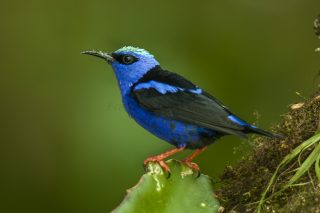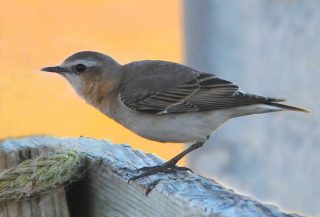
Red-legged Honeycreepers are stunning tropical birds normally found in central Mexico. One individual strayed into south Texas in 2014. It is now one of the 644 species on the official state checklist of birds. Wikimedia Commons Photo.
30 Sep 2016 – 644 Species…and Still Counting!
A bird checklist is a compilation of all the bird species you might find in a region. Have you ever wondered how these lists are compiled? Who decides what species are likely in a given area? How are new species added to those checklists?
When I first started birding many years ago, my first bird identification book was Roger Tory Peterson’s A Field Guide to the Birds of Texas and Adjacent States. It stated that I might find 540 species of birds in Texas. As of July of this year, Texas now has 644 species in good standing! What happened?
Several factors have caused this increase. First, there are more birdwatchers. More eyes definitely will result in more species seen. Observant and competent eyes may find something rare. One case in point is the Northern Wheatear. John Borntrager discovered one on his farm in Bee County in December of 2009. He alerted other birders, nearly all of whom made a trip to see the bird. This was indeed a rare find. Only one other Northern Wheatear had been seen in Texas and that one was discovered at the Laguna Atascosa National Wildlife Refuge in 1994.
The Northern Wheatear is now officially on the birds of Texas state checklist. Who decides what species are on that list? The Texas Bird Records Committee (TBRC) is who. This committee consists of nine voting members. The Texas Ornithological Society elects these individuals. Each member needs to have demonstrated expert ability in bird identification. The TBRC meets regularly to review records of “rare birds” submitted to the Committee. A “record” is documentation provided as “proof of the identity of a sighted, heard, collected, banded, or photographed bird.” The Committee examines the proof and discusses whether the bird should be added to the state checklist. The committee members vote on each record. The TBRC website maintains a list of Accepted Texas Species.

This Northern Wheatear showed up on the Borntrager farm in south Bee County during the winter of 2009-2010. Only the second discovery of a Wheatear in Texas, many intrepid birders travelled to Bee County to add the species to their life lists. Jimmy Jackson Photo.
The Northern Wheatear is one of the 104 birds added to that list since I began birding. I feel privileged to have added it to my “life-list” here in Bee County!
Just this year, the Red-legged Honeycreeper was added to the list of Texas species. It was sighted in Estero Llano Grande State Park (in Hidalgo County) in November of 2014. The Red-legged Honeycreeper is a bird that normally summers in the San Luis Potosi area of Mexico (300 miles south of the Texas border) and, in winter, it migrates to southern Mexico and Central America. So how did it get to Texas?
The obvious answer: It flew. If it flew, it headed the wrong direction for a migrating honeycreeper, so the TBRC had to consider other possibilities. Could it have been an escaped captive bird? Honeycreepers are colorful and sometimes kept as caged birds in Mexico. The experts at TBRC examined photos of the bird and determined that it wore juvenile plumage. That meant it had hatched the previous spring. The experts found no evidence of damage on its bill, feet, or feathers to suggest that it had been living in a cage. All this evidence led to the conclusion that this Honeycreeper got to Texas on its own. It was accepted as a new state record. This Red-legged Honeycreeper was a “wrong-way Corrigan” of birds.
It is likely that many species new to the state get here as the result of navigational errors. Storms, particularly at sea, can blow birds out of their usual ranges. Some birds join a flock in one area and stay with that flock even when it migrates. For example, a Common Crane (an Asian species) showed up in the Panhandle of Texas with a flock of Sandhill Cranes in 2014. Common Cranes and Sandhill Cranes have overlapping breeding grounds in Siberia. Presumably, this individual joined the Sandhill Cranes there and then came thousands of miles to Texas!
Another way the state list increases is when ornithologists have evidence that leads them to “split” an established taxon. This happened in 1998 when the Northern Oriole species was split into two different species: the Baltimore Oriole and the Bullock’s Oriole. This splitting was a reversal of an earlier decision (two decades before) when they had “lumped” the Baltimore and Bullock’s into a single species (Northern Oriole). Lumpers and splitters make their cases based on vocal or physical differences, documented cases of hybridization, and increasingly on molecular and DNA distinctions.
County checklists are compilations from mountains of data accumulated by birders reporting what they discover in that county. My husband and I are working with Jimmy Jackson to update the Bee County Bird Checklist. Mrs. Velma Geiselbrecht of Beeville began keeping records of bird sightings in the 1950s. Jimmy Jackson took over the list after her death and continued to add new records to it. Just this month, Jimmy added a new bird to the list. Ed McKay reported eight American Avocets on his stock tank northwest of Beeville. It is time the Bee County Bird Checklist had a facelift. We are entering the historical records into the eBird database with the goal of printing out a compilation of all Bee County records from Mrs. Geiselbrecht to the present. To date, we have well over 250 documented species on our Bee County Bird Checklist.
If you are a birder, chances are you have contributed to the Bee County checklist. If you are a casual observer, your sightings are welcome too. We hope to have an updated month-by-month abundancy checklist in your hands soon!
If you would like to offer comments, please click through to the discussion page
